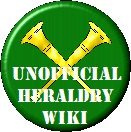Scottish Heraldry
WARNING: Do not cite this page as a reference. This page is on this wiki to make the content "searchable" and easier to find. If you find the information you seek here, go to the original sources (generally linked) to verify the information and use them for your documentation.
Information
Per Academy of Saint Gabriel Report 2511 some features typical of period Scots heraldry include:
- simple, balanced designs
- single charges or sets of three charges
- a group of identical charges around a fess, a bend, or a chevron
- strongly contrasting foreground and background colors; specifically, combinations of blue, red, or black with white/silver and yellow/gold
- canting, i.e. using a main charge whose name sounds similar to your surname.
Some features not used (or very rarely used) in Scots heraldry include:
- divided fields, especially of two colors or two metals
- man-made objects (except for canting)
- the colors green and purple
Ancient Scottish Patents and Matriculations, by David Hunter of Montlaw (alias David of Moffatt). - Text of some sixteenth- and seventeenth-century Scottish patents of arms.
An Annotated Bibliography of Scottish Heraldic Materials, by Zenobia Naphtali and David of Moffat. - Also available on the SCA website.
Period Scottish Armorials
- The Balliol Roll is a 14th C roll containing 36 Scottish coats of arms.
- Scots Roll is a Scottish roll from the 15th C with 114 coats of arms.
- The Lindsay of the Mount roll is a Scottish roll assembled in 1542 by David Lindsay of the Mount, who shortly later became Lyon King of Arms. A few coats were added later in the 16th C. It contains over 400 coats of arms from all over Scotland (including the Highlands).
- The Dunvegan Armorial is a Scottish roll from the end of the 16th C. It contains a color photofacsimile of over 50 noble coats of arms depicted in a full achievement (with crest and supporters.) and over 200 "Gentleman's arms" (with the escutcheons only.)
- The Dublin Armorial of Scottish Nobility dates from the end of the 16th C. It contains a color photofacsimile of pages depicting the marital coats of the various Kings of Scotland (Scotland to dexter, the Queen's original arms to sinister). It also includes over 50 noble coats of arms depicted in a full achievement (with crest and supporters.)
- Scottish Armorial, c 1560-1625 Scottish (London, Lambeth Palace Library, MS316) - http://images.lambethpalacelibrary.org.uk/luna/servlet/detail/LPLIBLPL~17~17~179079~125635
- Coats of arms of Scottish nobility, 4th quarter of the 16th C English (London, British Library, Harley MS 115) - http://www.bl.uk/manuscripts/FullDisplay.aspx?ref=Harley_MS_115
- Scottish Armorial, 16th-17th C Scottish (Manchester University Library, English MS 15) - https://luna.manchester.ac.uk/luna/servlet/view/search?q=reference_number=%22English%20MS%2015%22
- Scottish Nobility E2, post-1603, Scottish (Genealogical Office Manuscripts Collection, National Library of Ireland, Department of Manuscripts, GO MS 36) - http://catalogue.nli.ie/Record/vtls000531063
Examples:
Period:

|

|

|
Artifacts

|

|

|
| Information A | Information B | Information C |
Modern:
Pictorial Dictionary, 3rd edition:
Per Mistholme, may use PicDic art for submission purposes without prior permission.
Vector Graphics:
Annotated Pennsic Traceable Art Project
General Sources:
- Academy of St. Gabriel "Medieval Heraldry Archive" - http://www.s-gabriel.org/heraldry/
- Archive of St. Gabriel reports - http://www.panix.com/~gabriel/public-bin/archive.cgi
- Laurel Armory Articles - http://heraldry.sca.org/laurel/armory_articles.html
- https://iiif.biblissima.fr/collections/ - website that searches multiple great digital libraries
- New Heraldic Primer (Heraldry for Non-Heralds) - http://heraldry.sca.org/armory/newprimer/
- Pictorial Dictionary of Heraldry (PicDic), 3rd Edition - http://mistholme.com/pictorial-dictionary-of-heraldry
- Period Armorials
- Parker's Heraldry - https://www.heraldsnet.org/saitou/parker/index.htm
- Rietstap's Armorial Général - http://www.coats-of-arms-heraldry.com/armoriaux/rietstap.html
Precedents:
Precedents of the SCA College of Arms - http://heraldry.sca.org/laurel/precedents.html
Morsulus Heralds Website - http://www.morsulus.org/ (to search the LoARs and Precedents)
Use the above links to be sure any precedents listed below haven't been superseded by newer precedents.
Definition:
(includes defaults, proper tinctures, blazoning)
Example
Registerability:
(Restricted, Reserved, SFPP, OOP)
Conflict:
Identifiability:
Collected Precedents:
- 2nd Tenure of Elisabeth de Rossignol (April 2011 - August 2011) - Collected Armory Precedents
- 1st Tenure of Elisabeth de Rossignol (May 2005 - July 2008) - Collected Armory Precedents
- 2nd Tenure of François la Flamme (October 2004 - May 2005) - Collected Armory Precedents
- The Tenure of Shauna of Carrick Point (May 2004 - August 2004) - Collected Armory Precedents
- 1st Tenure of François la Flamme (August 2001 - April 2004) - Collected Armory Precedents
- The Tenure of Elsbeth Anne Roth (June 1999 - July 2001) - Collected Armory Precedents
- The Tenure of Jaelle of Armida (June 1996 - June 1999) - Single HTML Document
- 2nd Tenure of Da'ud ibn Auda (November 1993 - June 1996) -
- The Tenure of Bruce Draconarius of Mistholme (June 1992 - October 1993) - Collected precedents
- 1st Tenure of Da'ud ibn Auda (June 1990 - June 1992) -
- The Tenure of Alisoun MacCoul of Elphane (September 1986 - June 1990) - Collected Precedents
- The Tenure of Baldwin of Erebor (August 1984 - August 1986) - Single HTML Document
- The Tenure of Wilhelm von Schlüssel (August 1979 - August 1984) - Collected Precedents
- The Tenure of Karina of the Far West (December 1975 - June 1979) - Collected Precedents
- The Early Days (June 1971 - June 1975) - Collected Precedents
The Ordinary:
- add section link
WARNING: Do not cite this page as a reference. This page is on this wiki to make the content "searchable" and easier to find. If you find the information you seek here, go to the original sources (generally linked) to verify the information and use them for your documentation.
